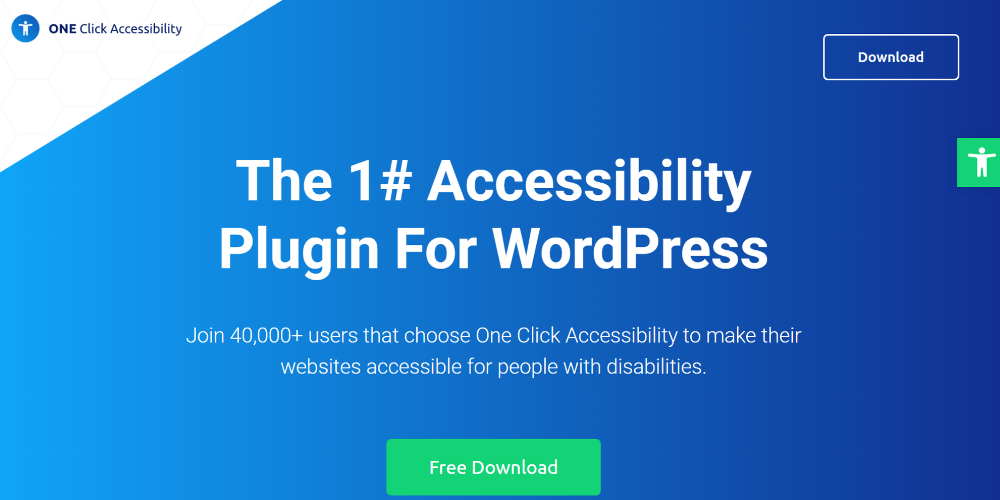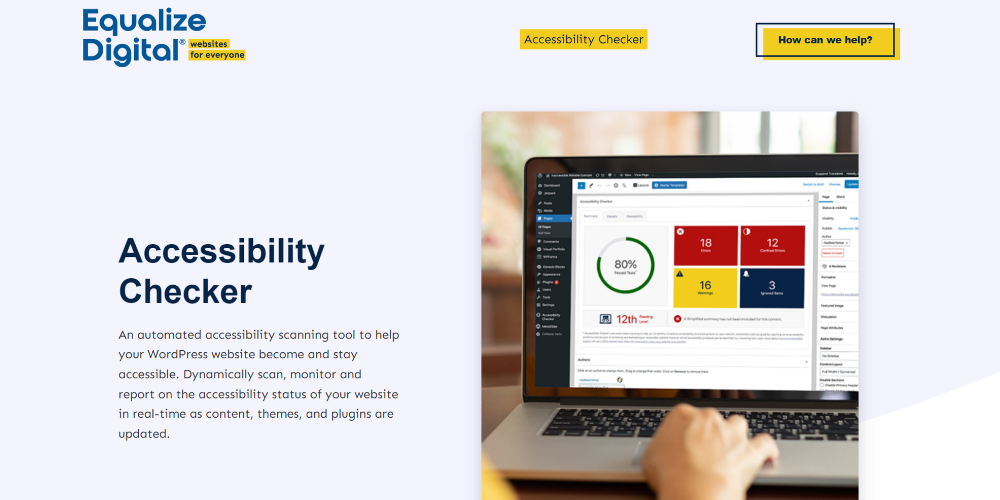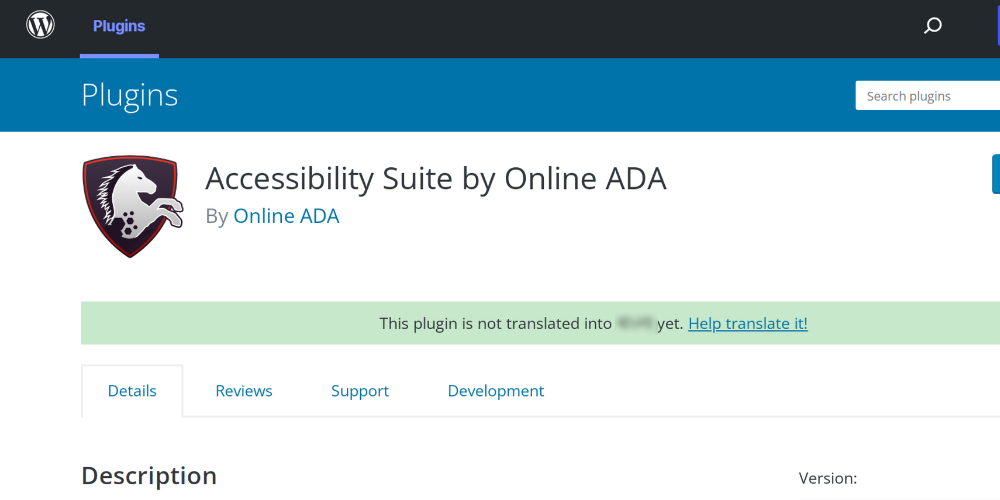The differently-abled users of a website need special attention. For example, users with disabilities need screen readers, large call-to-action buttons, high contrast color combinations, closed captions, image alt attributes, etc. Since you are busy creating content, social media engagement, and marketing, making your WordPress website more accessible would be costly and time-consuming. Instead, you can use the AI tools and plugins for WordPress websites that automatically format your web page design according to the best accessibility practices. Read on to find out what are WordPress accessibility plugins and their benefits. Furthermore, you will also know the trending WordPress plugins that offer better accessibility design support for your website or blog.
What Are WordPress Accessibility Plugins?
To understand WordPress accessibility plugins, you need to know the definition of website accessibility. Web page accessibility ensures that every internet user can consume content on the portal. Again, website consumption means navigating through the pages, understanding the visual or written content, and participating in website content creation. When audiences with cognitive, auditory, physical, neurological, visual, and speech disabilities can consume content on the web page, experts say the website is accessible. To ensure website developers follow a standard accessibility design practice, W3 Web Accessibility Initiative has created an international policy. It is commonly known as WCAG, aka the Web Content Accessibility Guidelines. It has many versions like WCAG 2.0, WCAG 2.1, and WCAG 2.2. If you are developing your website outside WordPress, you need to incorporate the aforementioned web page accessibility design guidelines manually. But, if you are managing your website inside WordPress, then there are automatic tools that can format your web portal according to the international accessibility standards. These WordPress content management system plugins are commonly known as WordPress accessibility plugins.
Importance of WordPress Accessibility Plugins?
Several stringent acts around the world safeguard the right of users with disabilities to access information technology-based services and products effortlessly. For example, the Americans with Disabilities Act Standards for Accessible Design, ADA compliance is mandatory for public-facing services based on IT like smartphones and websites. The Web Accessibility Directive of the EU also makes it mandatory that mobile apps and website developers build products that are accessibility compliant. Therefore, the primary benefit of using accessibility plugins is to comply with these digital content regulations and guidelines. There are also other important benefits like:
Website Reputation
If your website has better accessibility ratings, your online reputation increases drastically. Because the users see you as an inclusive business or company, they prefer you over other websites that do not follow the accessibility standards.
Increase Audience
When the website is accessible for users with disabilities, you get web traffic from all the sections of internet consumers. Increased traffic means better conversion probability and ultimately more revenue.
Increase SEO Ranking
It has been observed that if your website follows accessibility guidelines like alt text for images and closed captions for videos, the website performs better than those who do not offer these features. The followings are some of the best WordPress plugins website owners use to comply with ADA or EU accessibility norms:
One Click Accessibility
If you are an admin of your WordPress website and looking for an easy configuration and control of accessibility settings, you can try One Click Accessibility. The tool offers basic accessibility settings like ARIA landmarks, outline focus, clearing target attributes for links, and skip links. Moreover, its easy-to-use accessibility toolbar for WordPress sites can resize fonts, and underline links, enable negative contrast, trigger high contrast, and generate site maps. Above all, you can review the design changes visually before making those online. One-Click Accessibility not just transforms your WordPress website to comply with accessibility standards. It also makes your web page SEO-friendly. And, you get all these features for free since it is a free WordPress plugin.
UserWay
UserWay is another globally popular WordPress plugin for accessibility control, and it does not need existing website code refactoring. On top of this developer-friendly feature, you can get the plugin’s basic widget for free. The basic widget offers light, accessibility-friendly designs with up to 28 features. Thus, the free option is good for the trial however may not be sufficient for a full-fledged commercial website. UserWay’s accessibility features also increase website compliance with ATAG 2.0, WCAG 2.1, Section 508, and ADA. However, by only 20% of the requirements if you are on the free plan. This accessibility plugin has an AI that scans your WordPress site for accessibility issues and provides useful recommendations. One of the best features of UserWay is that it lets users navigate your website without any mouse.
accessiBe
Over 100,000 websites rely on accessiBe to comply with several accessibility standards globally. Its platinum clients include big names in the industry like GE, British Airways, Hilton, UCLA, Patek Philippe, etc. Therefore, if you need a comprehensive solution for website accessibility, you can give it a try. Its AI programming automatically scans your web page’s back end and front end to locate and resolve accessibility issues. For example, it can itself rectify icons, ARIA attributes, image alt texts, and forms. It can also help you modify the page structure to make it more keyboard-friendly. Moreover, the plugin keeps on scanning new content so that there is no accessibility settings mismatch between old and new content. accessiBe employs more than one, at least two, separate programs to accomplish maximum accessibility standard requirements. For example, the GUI accessibility interface of this WordPress accessibility plugin controls the design and user interface (UI) elements of your website and complies with WCAG 2.1 guidelines. On the other hand, the AI accessibility tool works in the background of your website. Whenever any differently-abled user requests full keyboard-based navigation or screen reader support, the AI handles those queries.
WP Accessibility Tools
The WordPress.org portal also offers some reliable, efficient, and easy-to-use accessibility plugins. One of the best from the WordPress plugins portal is WP Accessibility Tools & Missing Alt Text Finder. Like WordPress, this plugin is also an open-source project. Therefore, you can enjoy its services and benefit your website for free. The development team also actively monitors the plugin for bugs and releases updates frequently. For example, the latest version of the tool is 1.4, and it looks like the development team releases updates every few months. Speaking of compatibility, the tool supports various WordPress versions like 4.8 and above. The developers have also tested the plugin on WordPress 5.8.4. Furthermore, the tool is also compatible with PHP version 5.3 and higher. As of now, more than 4,000 WordPress sites use this plugin actively, and it has managed to secure a 5-star rating. Focusing on the tool features will reveal that the plugin only helps you become ADA Section 508 compliant. The developers also say that it comes with an automated checklist to show website shortcomings that stop your site from becoming WCAG 2.1 compliant. Hence, the tool should be a great accessibility settings auditor that suggests fixes. However, you need to implement those fixes on your own or with the help of a website developer. In addition to accessibility auditing, the plugin offers the following instant fixes: It lets you insert description text, caption text, and alt text for images one by one or with a single click.It has an inbuilt contrast ratio checker. Though the tool does not offer many features, but pretty okay since it is an open-source plugin, you can use the tool and rely on other fixes to achieve accessibility compliance.
Equalize Digital
Equalize Digital is another trusted tool for accessibility checking and fixing. You can get its free or paid accessibility audit tool to understand WordPress website issues. Then, you can sit with a developer to fix those. Or you can also get an accessibility design remediation service from Equalize Digital to make your website compliant with various accessibility standards. The accessibility audit performs tasks like issue scanning, monitoring for performance optimization, and reporting the accessibility status of the web portal. In addition, the scanning works in real-time, which means you do not need to stop uploading content, changing themes, or adding plugins, since the tool keeps on checking every change on the website.
Accessibility Suite
Accessibility Suite also comes from the WordPress.org portal and bears a 4-star rating on the plugin store of WordPress. As per the WordPress plugin portal, the tool has been tested up to the WordPress CMS version 5.8.4. So far, the tool has managed to secure more than 1,000 active installations. This accessibility plugin is essentially an auditing tool. So, you can use its WordPress scanner to pinpoint accessibility issues according to several international standards like ADA, Section 508, and WCAG. However, you will need to get in touch with a developer to fix those or rely on another WordPress plugin for fixes.
Conclusion
Website accessibility has become an essential attribute for public-facing web pages and portals. On top of that, if a website’s revenue depends on traffic, then it must comply with accessibility norms to attract a massive audience. Today’s developers take accessibility features seriously and address the issues during the initial development project. Also, website owners employ developers for site maintenance and accessibility fixing for updates and new content. If you are using WordPress, you have an advantage over other platform users. You do not need any developer to address accessibility issues. You can simply use any of the tools mentioned above to make your website accessible to differently-abled users.

![]()




























